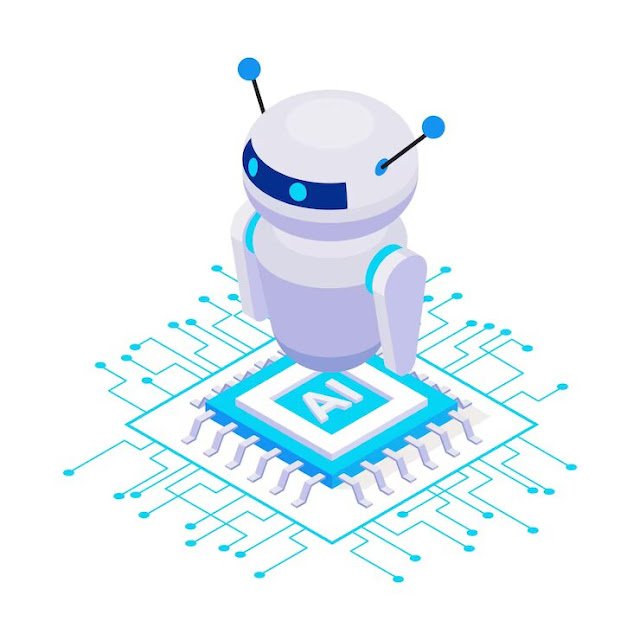Top Uses of Artificial Intelligence
Artificial intelligence and its uses
Artificial intelligence (AI) is a branch of computer science that aims to create intelligent machines that can behave and learn like humans. These machines can use data and algorithms to make decisions, recognize speech and recognize patterns. As artificial intelligence advances, machines can perform tasks that once required human intelligence, such as natural language processing, image recognition and decision making. Artificial intelligence has become increasingly important in today's society and is used in many industries to improve efficiency, accuracy and productivity.
Here are the top ways to use Artificial Intelligence
1) Uses of AI in Business:
Artificial intelligence has become an essential tool for businesses today to help them improve efficiency, productivity and profitability. Here are some of the main uses of AI in business:
Predictive analytics for business forecasting and decision making:
AI-powered predictive analytics can assist firms in forecasting demand, identifying trends, and making smarter data-driven decisions. Forecasting revenue, identifying client preferences, and optimizing pricing tactics are all examples of how predictive analytics can be employed. Companies may make better informed decisions, cut expenses, and improve income by utilizing artificial intelligence algorithms to evaluate huge volumes of data.
Chatbots for customer service and support:
AI-powered chatbots can give clients with 24/7 service, answering questions and providing assistance in real time. Chatbots can also assist in reducing customer wait times, increasing customer happiness, and freeing up human customer service personnel to handle more difficult issues. Chatbots can learn from client interactions and become more intelligent over time with the help of AI, providing a tailored and seamless customer experience.
Sales forecasting and optimization:
AI can assist firms in optimizing their sales strategy by forecasting which products or services are likely to sell the most, when they are likely to sell, and at what price. This can assist firms in optimizing their inventory, pricing, and promotional activities, resulting in increased sales and profitability. AI can also be used to uncover cross-selling and upselling opportunities, allowing firms to maximize their revenue per customer.
2) Uses of AI in Healthcare:
AI has the potential to transform the healthcare industry, improving patient outcomes and reducing costs. Here are some of the key uses of AI in healthcare:
Medical diagnosis and treatment planning:
AI can help clinicians identify diseases more precisely and rapidly by evaluating medical imaging, electronic health records, and other patient data. For example, AI algorithms can be used to identify cancer cells in medical photos, detect irregularities in electrocardiograms, and diagnose skin illnesses based on images. AI can also be used to create individualized treatment recommendations for patients based on their medical history, genetics, and lifestyle factors.
Personalized medicine and drug development:
AI can aid in the development of customized medicine by evaluating patient data and identifying biomarkers that predict drug response. This can assist clinicians in prescribing pharmaceuticals that are most likely to be beneficial for each individual patient, lowering the likelihood of adverse responses and increasing treatment outcomes. AI can potentially be used to speed medication research by evaluating massive volumes of data and selecting viable therapeutic candidates for further development.
Remote patient monitoring:
AI-powered remote patient monitoring can assist doctors in remotely monitoring patients' health, eliminating the need for in-person visits and increasing patient outcomes. Wearable devices, for example, can capture patient data such as heart rate, blood pressure, and glucose levels and communicate it to healthcare specialists for examination. AI systems can then be used to spot patterns and notify healthcare providers to potential issues before they become more serious.
3) Uses of AI in Education:
AI has the potential to transform the education industry, improving student outcomes and making learning more accessible and engaging. Here are some of the key uses of AI in education:
Personalized learning and adaptive teaching:
AI-powered personalized learning can assist students in learning at their own speed and level, while taking their learning style, strengths, and shortcomings into account. AI systems, for example, can examine student data such as test results and engagement with learning materials to generate individualized recommendations for further study. Adaptive teaching can also be used to modify the level of difficulty and content of learning materials in response to student progress, ensuring that each learner is pushed but not overwhelmed.
Intelligent tutoring systems:
AI-powered intelligent tutoring systems can provide students with tailored feedback and advice, enhancing their learning outcomes. Intelligent tutoring systems, for example, can provide real-time feedback on student performance, identify areas of weakness, and provide extra resources to assist students improve. These systems may also adjust to individual students' requirements and preferences, making for a more engaging and successful learning experience.
Automated grading and feedback:
Artificial intelligence (AI) can be used to automate grading and offer students with fast feedback on their work. AI systems, for example, can grade multiple-choice questions, detect plagiarism, and assess the quality of written responses. This can save teachers time and allow them to provide pupils with more individualized feedback.
4) Uses of AI in Transportation:
AI has the potential to revolutionize the transportation industry, improving safety, efficiency, and sustainability. Here are some of the key uses of AI in transportation:
Autonomous vehicles for safer and more efficient transportation:
AI-powered autonomous vehicles can help reduce traffic accidents by removing human error. Autonomous vehicles can also help to minimize traffic congestion and enhance fuel efficiency by optimizing driving patterns and decreasing stop-and-go traffic. Furthermore, autonomous vehicles can make transportation more accessible to those who are unable to drive, such as the old and crippled.
Traffic optimization and route planning:
AI may be used to manage traffic flow and alleviate congestion by monitoring traffic trends and predicting demand. This can help transportation companies create more effective routes to avoid congested regions, saving travel time and fuel usage. AI can also be utilized to deliver real-time traffic updates to drivers, assisting them in avoiding traffic congestion and accidents.
Predictive maintenance for vehicles:
AI may be used to predict vehicle maintenance requirements, minimizing downtime and boosting safety. AI algorithms can spot possible issues and recommend maintenance and repairs by evaluating data from sensors and other sources. This can help to reduce the costs associated with unexpected breakdowns and improve the lifespan of vehicles.
5) Uses of AI in Entertainment:
AI has the potential to transform the entertainment industry, providing new and innovative ways to create, distribute, and consume content. Here are some of the key uses of AI in entertainment:
Content recommendation systems:
AI-powered content recommendation systems can assist users in discovering new material based on their tastes and watching history. Streaming services, for example, utilize AI algorithms to recommend movies and TV episodes based on historical viewing history and user ratings. This can enhance the user experience by offering customised recommendations and assisting users in discovering new material.
Predictive analytics for box office success:
AI can be used to forecast box office success by evaluating data from previous films, social media, and other sources. Studio executives can make more educated judgments about which films to develop, how to sell them, and when to release them by analyzing this data with machine learning algorithms.
Creation of AI-generated art and music:
Artificial intelligence (AI) can be used to produce new types of art and music, such as generative art and music. In generative art, algorithms are used to generate unique pieces of art that are different each time they are viewed, whereas in generative music, algorithms are used to create music that changes over time. These new forms of art and music can provide artists new and unique ways to express themselves and engage their audiences.
6) Uses of AI in Government:
AI has the potential to transform the finance industry, improving the accuracy and speed of financial decision-making and reducing costs associated with manual processes. Here are some of the key uses of AI in finance:
Fraud detection and prevention:
AI can be used to detect and prevent fraudulent activity in the financial business. Machine learning algorithms can examine enormous volumes of data from numerous sources to find trends and anomalies that may suggest fraudulent behavior. This can assist financial institutions in detecting and preventing fraud before it causes substantial damage.
Risk assessment and portfolio optimization:
AI can be used to analyze risk and manage portfolios by analyzing data on market trends, investment performance, and other factors. Machine learning algorithms can recognize trends and forecast future events, allowing financial organizations to make more informed investment decisions.
Algorithmic trading and investment management:
Artificial intelligence (AI) can be used to automate trading and investment management procedures, increasing efficiency and lowering expenses. Machine learning algorithms can assess real-time market data and execute trades based on pre-defined rules and strategies. This can assist financial firms execute deals more quickly and accurately, as well as optimize their investing plans.
7) Uses of AI in Government:
AI has the potential to transform the way governments operate, improving decision-making processes and providing more efficient and effective services to citizens. Here are some of the key uses of AI in government:
Predictive policing and crime prevention:
AI can be used to anticipate and prevent crimes by evaluating data from previous criminal behaviors, social media, and other sources. Machine learning algorithms can detect trends and forecast future criminal activities, allowing law enforcement to prevent crimes before they occur.
Public safety and emergency response:
AI may be used to improve public safety and emergency response by evaluating real-time data from multiple sources such as traffic cameras, sensors, and social media. Machine learning algorithms can identify potential threats and provide insights to first responders, allowing them to respond to situations more effectively.
Intelligent transportation systems:
AI may be used to optimize transportation networks by evaluating data on traffic patterns, accidents, and other factors. Machine learning algorithms can predict traffic congestion and recommend alternate routes, decreasing travel time and boosting overall transportation efficiency.
8) Uses of AI in Environmental Sustainability:
AI has the potential to address some of the most pressing environmental challenges by providing insights into complex environmental systems, optimizing resource use, and improving conservation efforts. Here are some of the key uses of AI in environmental sustainability:
Energy efficiency and optimization:
AI can be used to optimize energy utilization in buildings and industrial operations by evaluating data on energy consumption, weather patterns, and other factors. Machine learning algorithms can discover energy-saving opportunities and recommend ideal heating, cooling, and lighting system settings.
Climate modeling and prediction:
AI may be used to construct climate models and predict the effects of climate change by evaluating data on weather patterns, ocean currents, and other factors. Machine learning algorithms can recognize patterns and forecast future outcomes, providing insights into the effects of climate change and directing policy decisions.
Conservation and wildlife protection:
AI may be used to assist conservation efforts and safeguard animals by analyzing data on species numbers, habitats, and threats. Machine learning algorithms can recognize trends and forecast future events, allowing conservationists to devise more effective ways to safeguard endangered species and habitats.
Conclusion
Artificial intelligence is transforming the way we live and work, providing new opportunities to address some of the most pressing challenges we face. From healthcare and education to transportation and entertainment, AI is being used to improve decision-making processes, optimize resource use, and enhance the overall quality of life.
If you're looking to leverage the power of AI in your organization, working with an AI development company can help you get started. These companies can provide you with the expertise and resources you need to develop custom AI solutions that meet your specific needs, whether it's improving customer service, optimizing operations, or driving innovation in your industry.




Comments
Post a Comment